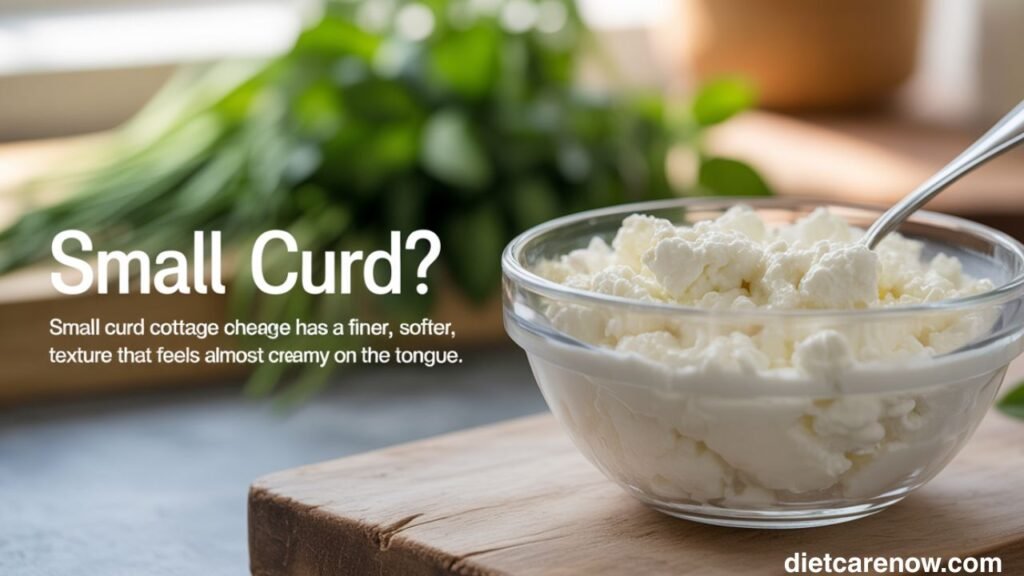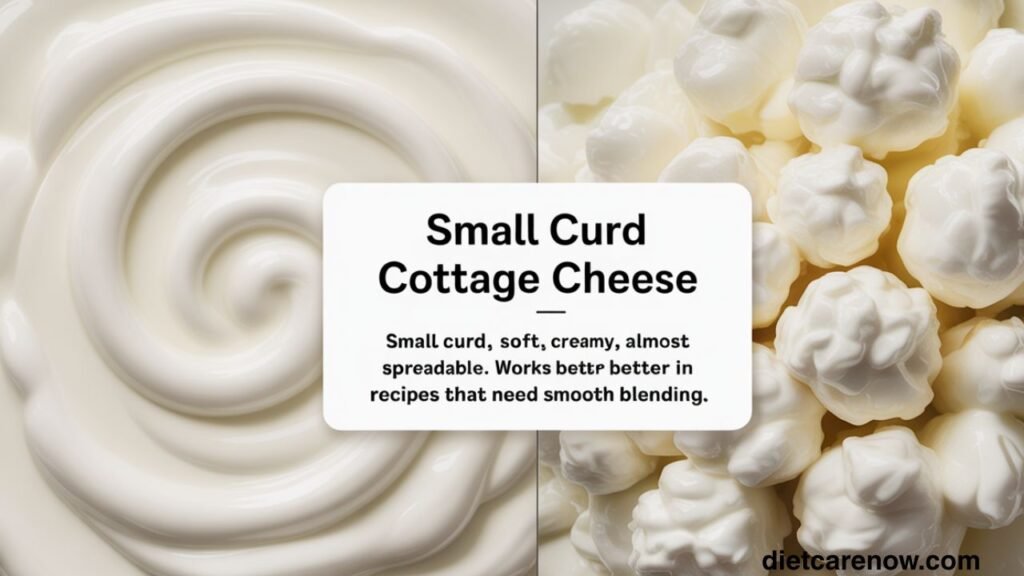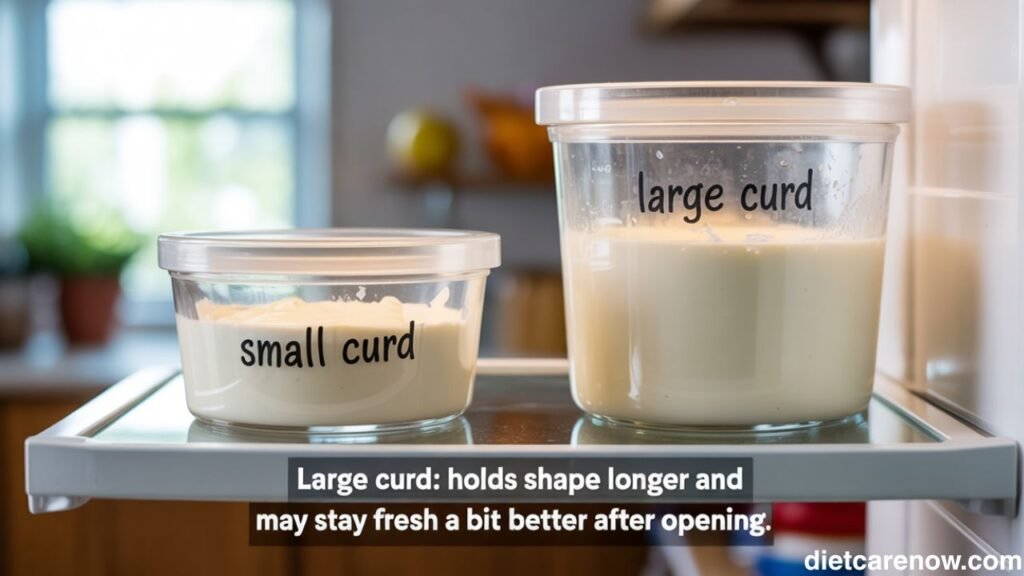Cottage cheese is one of those foods that has been around for centuries yet still sparks debate among fans. Some prefer it smooth and creamy, while others like it chunky and hearty. This difference often comes down to curd size: small curd or large curd.
If you’ve ever stood in front of the dairy aisle wondering whether to grab small curd or large curd cottage cheese, you’re not alone. The two might look similar, but they differ in how they’re made, how they taste, and how they fit into recipes. Understanding these differences can help you pick the one that works best for your diet, cooking style, or simply your taste buds.This guide breaks down everything you need to know about small curd vs large curd—from how they’re made to which one pairs better with certain dishes.
What is Small Curd?
Small curd cottage cheese has a finer, softer texture that feels almost creamy on the tongue. The curds are small because of the way the milk is coagulated.
How it’s made:
- Small curd is usually produced using an acid-set process, often with vinegar or lemon juice, though commercial producers may use lactic acid cultures.
- The acid causes the milk proteins to coagulate quickly, forming tiny curds.
Popular uses:
Because it’s less chunky, small curd mixes smoothly into spreads, dips, or smoothies. It’s also a go-to choice for people who eat cottage cheese plain, right out of the container.
Also read: /salmon-cake-nutrition/

What is Large Curd?
Large curd cottage cheese has a chunkier, firmer texture. You’ll notice bigger, more distinct pieces of curd when you scoop it out.
How it’s made:
- Large curd is typically produced with rennet, an enzyme that coagulates milk more slowly than acid.
- This slow setting process allows larger, more defined curds to form.
Popular uses:
Large curd works well in salads, casseroles, lasagna, and baked recipes where the curds hold their shape. People who like a heartier mouthfeel also tend to prefer it plain.
The Role of Coagulation in Curd Size
The difference in curd size comes down to the science of coagulation.
- Acid coagulation (small curd): Milk proteins (casein) tighten quickly under the influence of acid, which prevents large clumps from forming.
- Rennet coagulation (large curd): Rennet allows the proteins to bond slowly, creating larger curds with less acidity.
In short, the speed and method of coagulation decide whether you end up with smooth, fine curds or chunky, distinct ones.
Taste Differences Between Small and Large Curd
At first glance, you might think both types taste the same. But side by side, differences become clear:
- Small curd: Tangier, slightly more acidic due to the acid-set method. Some describe it as having a fresher, brighter flavor.
- Large curd: Milder, creamier, and less tangy. Because it’s less acidic, it tastes richer and smoother.
Consumer preferences:
Those who like cottage cheese as a snack often lean toward small curd for its fresh tang, while large curd appeals to people looking for a creamier, subtler flavor.
Texture and Mouthfeel Comparison
Texture is the biggest factor when choosing between small and large curd.
- Small curd: Soft, creamy, almost spreadable. Works better in recipes that need smooth blending.
- Large curd: Chunky, chewy, more bite to each spoonful. Works better in baked dishes or salads where you want distinct texture.
Think of small curd as “smooth and snackable” and large curd as “hearty and filling.”

Nutritional Value: Small Curd vs Large Curd
Nutritionally, the two are nearly identical since both are made from milk. However, there can be slight variations depending on the brand.
On average (per ½ cup serving, low-fat):
- Calories: 80–110
- Protein: 11–13g
- Fat: 2–5g
- Carbs: 3–5g
Lactose content:
Small curd may taste tangier because of more residual lactose fermentation, but both types still contain lactose. Lactose-free options are also available.
Which is healthier?
It depends on your goals:
- For weight loss: Both are low-calorie, high-protein.
- For muscle gain: Either works, but some athletes prefer large curd for its creamier texture in bulk meals.
- For low-carb diets: Both are suitable.
Cooking and Recipe Applications
Both small and large curd shine in different dishes.
- Best uses for small curd:
- Smoothies and protein shakes
- Spreads for toast or crackers
- Dips with herbs or seasoning
- Pancakes, muffins, or baked goods where you want moisture without chunks
- Best uses for large curd:
- Salads (fruit salad, pasta salad)
- Casseroles and lasagna
- Baked dishes where curds should stay intact
- Side dish with fruit or honey
Substitution tip:
If a recipe calls for one type and you only have the other, you can swap them. Just remember: small curd blends smoothly, while large curd keeps its shape.
Popular Brands and Availability
In the U.S., most major grocery stores carry both small and large curd. Some common brands include:
- Small curd: Daisy, Hood, Breakstone’s, store-brand options
- Large curd: Knudsen, Friendship, Prairie Farms, and some organic brands
Organic and specialty options: Organic Valley, Good Culture, and Nancy’s often sell both types, focusing on clean ingredients and live probiotics.
Price differences: Large curd is sometimes slightly more expensive due to the rennet process, but generally, the price difference is small.
Shelf Life and Storage Differences
Curd size doesn’t drastically change shelf life, but there are small differences.
- Small curd: Because it has more surface area and sometimes more acidity, it may spoil slightly faster.
- Large curd: Holds shape longer and may stay fresh a bit better after opening.
Storage tips:
- Keep refrigerated and sealed tightly.
- Consume within 5–7 days after opening.
- Freezing isn’t ideal—it changes texture—but if necessary, use thawed cottage cheese in cooked dishes, not for fresh eating.

Cultural and Regional Preferences
Preferences often depend on where you live:
- United States: Both are popular, though small curd dominates in some regions.
- Europe: Large curd varieties (sometimes called “farmer’s cheese”) are more common.
- Historical note: Cottage cheese dates back hundreds of years as a farmhouse staple, with curd size varying by local tradition and available techniques.
Health and Dietary Considerations
Cottage cheese, whether small or large curd, is versatile in many diets.
- Weight loss: High protein and low calorie. Small curd’s tanginess may make it more satisfying as a snack.
- Muscle gain: Popular among athletes for protein and casein content. Large curd often feels more filling in big meals.
- Low-carb/keto: Works for both.
- Vegetarian diets: Small curd made with acid-set is vegetarian-friendly. Large curd may not be if rennet comes from animal sources. Many brands now use microbial or vegetarian rennet.
Consumer Buying Guide: How to Choose
If you’re standing in the dairy aisle unsure which to grab, here are some tips:
- Choose small curd if: You like tangy flavor, smooth texture, or want to use it in spreads, dips, or baked goods.
- Choose large curd if: You prefer mild flavor, chunky texture, or plan to use it in salads, casseroles, or as a side dish.
- Diet goals: Both work for high-protein, low-calorie diets. Check labels for fat content if you’re tracking macros.
- Best advice: Try both. Cottage cheese is inexpensive, and you may find you enjoy each for different purposes.

Common Misconceptions About Small and Large Curd
- Myth: Large curd is always creamier.
Not necessarily. Creaminess also depends on milk fat percentage. A 4% milkfat small curd can feel creamier than a 1% large curd. - Myth: Small curd is healthier.
Both types have nearly identical nutrition; the difference is mainly in taste and texture. - Myth: “Cream-style” means large curd.
Cream-style refers to added cream for richness, not curd size. You can find both small and large curd in cream-style versions.
Conclusion: Which One Should You Choose?
When it comes to small curd vs large curd, there’s no right or wrong choice. It all comes down to personal taste and how you plan to use it.
- Small curd is tangier, smoother, and great for snacks, dips, and blending.
- Large curd is milder, chunkier, and perfect for salads, casseroles, and hearty meals.
If you’re unsure, grab both and experiment. You might find small curd better in your morning smoothie and large curd more satisfying alongside dinner. The beauty of cottage cheese is its versatility—you don’t have to choose just one.

